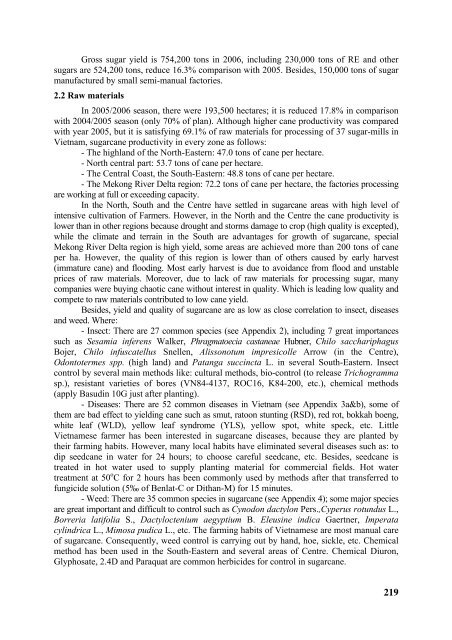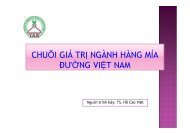TUYEÅN TAÄP
tuyeÃ¥n taäp - CHUYÃN TRANG GIá»I THIá»U CÃC GIá»NG MÃA Tá»T ...
tuyeÃ¥n taäp - CHUYÃN TRANG GIá»I THIá»U CÃC GIá»NG MÃA Tá»T ...
- No tags were found...
You also want an ePaper? Increase the reach of your titles
YUMPU automatically turns print PDFs into web optimized ePapers that Google loves.
Gross sugar yield is 754,200 tons in 2006, including 230,000 tons of RE and other<br />
sugars are 524,200 tons, reduce 16.3% comparison with 2005. Besides, 150,000 tons of sugar<br />
manufactured by small semi-manual factories.<br />
2.2 Raw materials<br />
In 2005/2006 season, there were 193,500 hectares; it is reduced 17.8% in comparison<br />
with 2004/2005 season (only 70% of plan). Although higher cane productivity was compared<br />
with year 2005, but it is satisfying 69.1% of raw materials for processing of 37 sugar-mills in<br />
Vietnam, sugarcane productivity in every zone as follows:<br />
- The highland of the North-Eastern: 47.0 tons of cane per hectare.<br />
- North central part: 53.7 tons of cane per hectare.<br />
- The Central Coast, the South-Eastern: 48.8 tons of cane per hectare.<br />
- The Mekong River Delta region: 72.2 tons of cane per hectare, the factories processing<br />
are working at full or exceeding capacity.<br />
In the North, South and the Centre have settled in sugarcane areas with high level of<br />
intensive cultivation of Farmers. However, in the North and the Centre the cane productivity is<br />
lower than in other regions because drought and storms damage to crop (high quality is excepted),<br />
while the climate and terrain in the South are advantages for growth of sugarcane, special<br />
Mekong River Delta region is high yield, some areas are achieved more than 200 tons of cane<br />
per ha. However, the quality of this region is lower than of others caused by early harvest<br />
(immature cane) and flooding. Most early harvest is due to avoidance from flood and unstable<br />
prices of raw materials. Moreover, due to lack of raw materials for processing sugar, many<br />
companies were buying chaotic cane without interest in quality. Which is leading low quality and<br />
compete to raw materials contributed to low cane yield.<br />
Besides, yield and quality of sugarcane are as low as close correlation to insect, diseases<br />
and weed. Where:<br />
- Insect: There are 27 common species (see Appendix 2), including 7 great importances<br />
such as Sesamia inferens Walker, Phragmatoecia castaneae Hubner, Chilo sacchariphagus<br />
Bojer, Chilo infuscatellus Snellen, Alissonotum impresicolle Arrow (in the Centre),<br />
Odontotermes spp. (high land) and Patanga succincta L. in several South-Eastern. Insect<br />
control by several main methods like: cultural methods, bio-control (to release Trichogramma<br />
sp.), resistant varieties of bores (VN84-4137, ROC16, K84-200, etc.), chemical methods<br />
(apply Basudin 10G just after planting).<br />
- Diseases: There are 52 common diseases in Vietnam (see Appendix 3a&b), some of<br />
them are bad effect to yielding cane such as smut, ratoon stunting (RSD), red rot, bokkah boeng,<br />
white leaf (WLD), yellow leaf syndrome (YLS), yellow spot, white speck, etc. Little<br />
Vietnamese farmer has been interested in sugarcane diseases, because they are planted by<br />
their farming habits. However, many local habits have eliminated several diseases such as: to<br />
dip seedcane in water for 24 hours; to choose careful seedcane, etc. Besides, seedcane is<br />
treated in hot water used to supply planting material for commercial fields. Hot water<br />
treatment at 50 o C for 2 hours has been commonly used by methods after that transferred to<br />
fungicide solution (5‰ of Benlat-C or Dithan-M) for 15 minutes.<br />
- Weed: There are 35 common species in sugarcane (see Appendix 4); some major species<br />
are great important and difficult to control such as Cynodon dactylon Pers.,Cyperus rotundus L.,<br />
Borreria latifolia S., Dactyloctenium aegyptium B. Eleusine indica Gaertner, Imperata<br />
cylindrica L., Mimosa pudica L., etc. The farming habits of Vietnamese are most manual care<br />
of sugarcane. Consequently, weed control is carrying out by hand, hoe, sickle, etc. Chemical<br />
method has been used in the South-Eastern and several areas of Centre. Chemical Diuron,<br />
Glyphosate, 2.4D and Paraquat are common herbicides for control in sugarcane.<br />
219






